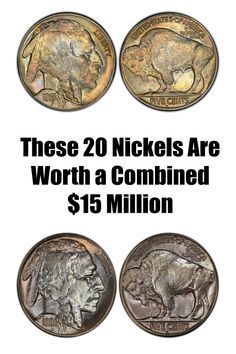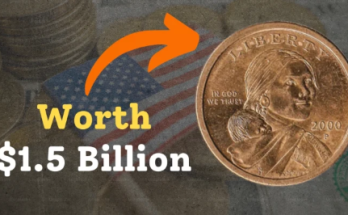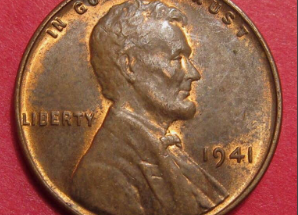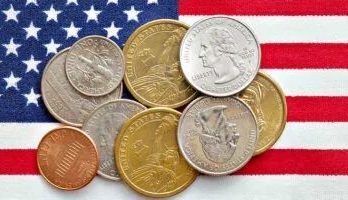:quality(80)/granite-web-prod/e5/59/e55978799db14e3a8dfc9757008a8d4d.jpg)
A coin valued at five cents was the first official coin of the United States (in 1792), but nickels did not appear in the U.S. until 1866. On May 16 of that year, Congress passed an act to usher in the new five-cent coin, made of 25 percent nickel and 75 percent copper.
Over the next seven years, the Mint produced nickels and silver half dimes, before phasing out the half dimes. There are four basic nickel designs: Shield, Liberty, Buffalo and the Jefferson, with only slight variations in early coins. The 2004-05 coins commemorated Lewis & Clark’s journey and the obverse of the coin — the side with the head, typically — got a makeover in 2006.
The value of coins varies by demand and is influenced by rarity and condition. In the U.S., two main organizations, the Professional Coin Grading Service (PCGS) and Numismatic Guaranty Corporation (NGC), evaluate coins using the Sheldon Scale to assign a numerical rating, from 1 to 70. Coins rated 60 or higher are referred to as “mint” state coins. Gem coins are rated 66 or higher, and they possess exemplary strike and luster and no noticeable abrasions.
So what nickels are worth money? You’re not likely to find any of the following 20 nickels under your couch cushions. But if you do, don’t spend it. These are the most valuable nickels, and they are worth a combined $15 million.
Bottom Line: 1880 Shield Nickel
:quality(80)/granite-web-prod/3a/e9/3ae934ac8ba34ca18a7cad859bd32455.jpeg)
Only 16,000 nickels were produced in 1880, and only 100 to 150 are known to still exist.
A raised lump just below the TE of STATES shows this coin to be one stuck for circulation rather than as a proof.
Very few of these coins remain at the gem level and reach valuable collector’s item status. Only two are certified at a higher grade than this one.
Bottom Line: 1867 Rays Shield Cameo Nickel
:quality(80)/granite-web-prod/1a/bd/1abd552f180a4eadbcc0ec672f9ed40f.jpeg)
Three different obverse dies were used to produce the 1867 Rays Shield nickel proofs. Due to a design issue, the coinage dies failed early, resulting in the decision to remove the rays from the coin mid-year.
This coin appears to be struck from Die State 1. The frost on the surface of this coin elevates it to a cameo designation.
Cameo is the amount of contrast between the relief (raised or recessed design) and field (background).
Bottom Line: 1927-S Buffalo Nickel
:quality(80)/granite-web-prod/80/82/8082df66cfcd46d3b90ff58e8e417a7b.jpeg)
While common among circulated coins, the 1927-S is rare in mint state and one of the rarest Buffalos when in gem condition, with only three other Buffalo years rarer.
This is the highest graded coin of its type.
Bottom Line: 1918-S Buffalo Nickel
:quality(80)/granite-web-prod/9a/d1/9ad1e5dc6b1c4cb493fffbcf82153830.jpeg)
The 1918-S is a scarce coin in any state and rare in mint state.
This coin is graded gem quality, making it the rarest regular strike Buffalo nickel between 1913 and 1919.
Bottom Line: 1867 Rays Cameo Proof Shield Nickel
:quality(80)/granite-web-prod/21/86/218628deba50413fb615767110686eb7.jpeg)
It’s believed that the original proofs were struck on Feb. 8, 1867 and there are no more than 10 known to remain from the original 25.
Restrikes were apparently produced later. This coin has a frost, which provides a cameo effect on each side.
Bottom Line: 1917-S Buffalo Nickel
:quality(80)/granite-web-prod/87/27/872770272c8d40cab85fd6e8aca016b2.jpeg)
The majority of 1917-S nickels were not well struck and show significant die erosion.
This coin, the finest certified by both major services, is well struck with an unusually sharp image and has only a small amount of die erosion.
Bottom Line: 1920-D Regular Strike Buffalo Nickel
:quality(80)/granite-web-prod/5c/1f/5c1f36f068804d168de04400235c2e54.jpeg)
About 9.5 million nickels were produced at each of the Denver and San Francisco Mints in 1920, compared to more than 63 million in Philadelphia.
It’s estimated that only 80 of these coins exist in mint state. This nickel is rarer that all of the 1924 to 1938 D nickels with the exception of the 1927 D, which is equally as rare.
Bottom Line: 1913-D Buffalo Nickel — Type 2
:quality(80)/granite-web-prod/9b/55/9b5595f628424156a08d5d9984515453.jpeg)
The 1913 Type 2 nickels from both the Denver and San Francisco Mints had a low mintage.
While the 1913-D is not quite as rare as the 1913-S, it is one of the most difficult Buffalo nickels to find in any condition.
This coin is of the highest quality and as such is equal in rarity to most other early nickels from these mints.
Bottom Line: 1918/7-D Buffalo Nickel
:quality(80)/granite-web-prod/ca/d0/cad0acefd45f48afbfd4385bf1f1f198.jpeg)
This coin is one of the finest examples of its kind.
With only a faint fleck of carbon seen before the Indian’s chin, it is rated as a gem.
Bottom Line: 1916 Doubled Die Obverse Nickel
:quality(80)/granite-web-prod/5b/ab/5babde802db54b6b8739f2c99f5cd6b1.jpeg)
Graded the seventh finest nickel of its type, this coin is in mint condition.
Bottom Line: 1918/7-D Buffalo Nickel
:quality(80)/granite-web-prod/61/9a/619ab1ced03c47249f3ac5b58330a48c.jpeg)
One of only two coins in its grade, this coin is the fifth finest example of the 1918/7-D Buffalo nickel.
A small carbon spot on the neck likely contributes to its grade that is just short of a gem.
9. 1880 Shield Nickel
:quality(80)/granite-web-prod/4b/fc/4bfc638599a7483b9062d7e4f1305663.jpg)
Sold on eBay: $175,000
Bottom Line: 1880 Shield Nickel
:quality(80)/granite-web-prod/ec/52/ec521257b4624548b2afddfaabbfbba6.jpeg)
At only 16,000, the 1880 Shield Nickel had one of the lowest mintages of the Shield series.
This mint condition coin is one of two determined to be of the highest grade for a nickel of this year.
Bottom Line: 1916 Doubled Die Obverse Buffalo Nickel
:quality(80)/granite-web-prod/31/a4/31a49d8f73514dcdaa6825d3d4f3f795.jpeg)
In circulated condition, there are only 100 to 150 of these nickels, with no more than 10 coins in mint condition.
Though it has a small corrosion mark on the obverse, it is still considered one of the finest examples that remain.
Bottom Line: 1916-D Buffalo Nickel — Doubled Die Obverse
:quality(80)/granite-web-prod/97/d5/97d5bd0f8bcf49baac5b313106b0e65a.jpeg)
Only about 200 examples of this coin are known to exist, with less than 15 in mint condition. This coin is one of the two finest examples.
The doubling can be seen both on the date and on the Indian chief’s lip and chin.
Bottom Line: 1926-S Regular Strike Buffalo Nickel
:quality(80)/granite-web-prod/5c/b6/5cb614dadbc14a15ba633590b6e5711b.jpeg)
The 1926-S is the rarest non-variety Buffalo nickel, even in circulated grades. A 7 can be seen under the 8 in the date.
Only 970,000 coins were struck, compared to over a million in other years.
Only 17 nickels are certified to be gem condition as this one is.
Bottom Line: 1918/7-D Buffalo Nickel
:quality(80)/granite-web-prod/b5/d7/b5d73f53fd1f408eb62fe78531f5d4c9.jpeg)
Since so many World War I soldiers overseas had at least a few small coins in their pockets, there was a shortage of nickels in 1917 and 1918. The rush to produce more coins resulted in a hubbing error in late 1917.
A die that had already been impressed with “1917” was also impressed with “1918,” resulting in an overdate. While the exact mintage is uncertain, it is estimated at 100,000 coins. An estimate of those surviving in mint condition is about two dozen.
Those that were circulated often are dateless due to wear. Seven are graded at the gem level like this one, but only one other nickel is of as high quality.
Bottom Line: 1964 Jefferson Mirror Brockage on Reverse
:quality(80)/granite-web-prod/e9/db/e9db353a0044460a863ac95a68871101.jpeg)
Listed as a “two headed” coin, (only one of these is known to exist, a 2000 Jefferson Nickel) this coin is actually a brockage, an error where a mirror image of a coin is struck on each side of a coin.
In this case, two “head” sides of the coin appear, making it unique.
Bottom Line: 1913 Liberty Head Nickel
:quality(80)/granite-web-prod/e2/af/e2af7a39ad8647de9bf09407e90ac366.jpeg)
The third of the five coins currently in private hands, the Walton specimen and the McDermott coin (which is displayed at the ANA Money Museum in Colorado Springs) are the only two that are flatly struck across the coin on the reverse.
A collector and dealer, George O. Walton repeatedly denied owning the coin, instead saying he had “access to the coin whenever he wanted to display it.” He also had a fake coin that he passed around casually.
This original 1913 coin was sold at auction 30 years after his death, having passed through several owners.
Bottom Line: 1913 Liberty Head Nickel
:quality(80)/granite-web-prod/ca/50/ca50c35d15f542dc8093cc8cae897145.jpeg)
One of the five 1913 Liberty Head Nickels, the Olsen Specimen passed hands several times since it was split from the Green Collection.
At one time, this coin was sold to King Farouk of Egypt, who considered it redundant since he had already acquired the Norweb coin that currently resides at the Smithsonian Institution.
Bottom Line: 1913 Liberty Head Nickel
:quality(80)/granite-web-prod/06/69/0669c9c38bea4380a4f6e8e79064958b.jpeg)
The 1913 Liberty Head Nickel is one of the most coveted coins in U.S. coin collecting history. Only five examples of uncirculated coins are known to exist, and as early as 1920, all five were owned by one individual, Samuel W. Brown, and later sold to Col. Edward H.R. Green.
After Green’s death, they were purchased from his estate and then disbursed. This coin was purchased by Louis E. Eliasberg Sr. in 1948. Two are now held by public institutions.
This one, known as the Eliasberg specimen, is the finest of the five and possesses a surface like that of a proof coin.

:quality(80)/granite-web-prod/cf/c3/cfc37bf30c1e4a0288930c480b1e4920.jpg)
:quality(80)/granite-web-prod/2a/9c/2a9c0b9fa7dc4c3eb8256ad51bde61f1.jpg)
:quality(80)/granite-web-prod/07/d0/07d098a422f74c6c98e031038a01194c.jpg)
:quality(80)/granite-web-prod/20/cf/20cf886a50c24c1298661f7a74d474e7.jpg)
:quality(80)/granite-web-prod/38/3d/383d45c2595d408d8a97f7876f35c99e.jpg)
:quality(80)/granite-web-prod/db/8a/db8ae46aa66047848d39b077c86c0b3e.jpg)
:quality(80)/granite-web-prod/b9/79/b979a7dca9f745a8be5e86c2ee71da13.jpg)
:quality(80)/granite-web-prod/44/dc/44dc852da9b743efb934c74c890ae319.jpg)
:quality(80)/granite-web-prod/4f/98/4f9873da81c9429484804b94d947336f.jpg)
:quality(80)/granite-web-prod/84/6d/846dc8ee8af642d7817988fc610ffb15.jpg)
:quality(80)/granite-web-prod/44/3c/443cdf4de1234750bc15a55fe9d26088.jpg)
:quality(80)/granite-web-prod/df/2a/df2a27bff7464b97bf9041103b476b68.jpg)
:quality(80)/granite-web-prod/de/8f/de8f99513e6248a38fa6107509130f7c.jpg)
:quality(80)/granite-web-prod/46/00/4600ed464d704665a1b6afc1880036a5.jpg)
:quality(80)/granite-web-prod/72/71/7271834db5a443e996cb3e0ee99e29bf.jpg)
:quality(80)/granite-web-prod/d9/02/d9026c7ef5f64804b533dcbcb4be132d.jpg)
:quality(80)/granite-web-prod/e7/22/e722378082354aed9f7a62407e165e7b.jpg)
:quality(80)/granite-web-prod/26/0d/260dcba8ca124cef8d0918d244040ba4.jpg)
:quality(80)/granite-web-prod/4e/ba/4ebaacf3d8a74ea2a539bda82b565576.jpg)


